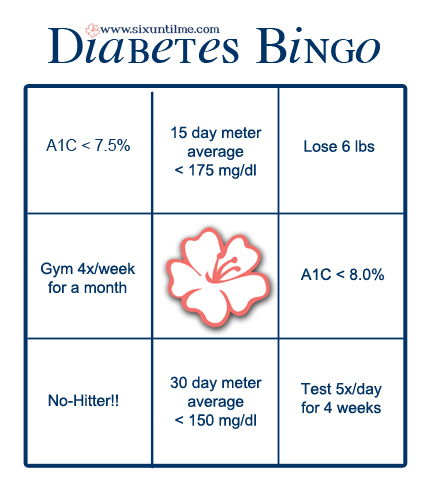January 29th, 2011 by KerriSparling in Health Tips, True Stories
No Comments »

Recently, I reconnected with a long-lost local PWD (person with diabetes) named Ryan. Last time Ryan and I saw one another we were talking about diabetes goal-setting and dealing with wicked bouts of burnout. And this week I received an email from him with a brilliant idea about how to stay motivated towards setting — and reaching — diabetes-related goals.
“I’ve had this ‘pyramid’ for about three months now. Just something that I keep near my desk to keep me focused on my diabetes. After completion of the pyramid, I have no clue what I will do but some kind of celebration will be in order,” he wrote, and attached a slide to his image. And when I opened it, I was like “whoa.”
He had created a pyramid of his diabetes goals. Tangible goals — real-life goals — that are both achievable and ambitious, all at once. I thought this was so clever because it is a constant but non-threatening reminder of what diabetes goals are most top-of-mind for him. (Also, having a celebration at the end of that pyramid completion sounds like a quality idea. Perhaps a Fudgy the Whale?)
I’ve been working towards gaining better control of my diabetes (and overall health) lately, and I love the idea of something I can print out, stick to my fridge, and remain inspired by. I liked the idea of a pyramid, but I kept picturing a huge bingo hall in my mind, with a whole bunch of PWDs sitting at the tables with glucose tabs and bingo markers at the ready. But the trick wasn’t getting four in a row, it was filing the whole card.
I thought about my own personal goals and created this:

There are a few not-necessarily-diabetes-related goals on there (like “lose 6 pounds,” which is because I’m still trying to de-flump), but there are a lot of diabetes goals that aren’t unique to my particular circumstances. Since I’m trying to emerge from some diabetes burnout, my goals aren’t as tight as they were a few months ago (i.e. the slow progression from an A1C over 8 to one under 7.5). But these are real, and I’m hoping to fill the card within six months. Thanks for the fun idea, Ryan!
What would be on your bingo card?
*This blog post was originally published at Six Until Me.*
January 9th, 2011 by KerriSparling in Better Health Network, Humor, True Stories
No Comments »

Last week we were at the airport to travel to Marco Island for the CWD Family Weekend. And we were NOT traveling light, by any stretch. Chris and I had our suitcases, our laptops, and my diabetes supplies (infusion sets, insulin, test strips, glucose tabs, etc.) stashed in a carry on. Oh, and we also had that giggly baby BSparl, plenty of clothes for her to spit up on, formula, bottles, wipes, diapers, water for mixing the formula, toys, Happy Baby puffs for snacks, her car seat, the car seat base, and the stroller. (Phew.)
In addition to all the junk we were carrying, I was also wearing my Animas Ping and my Dexcom sensor (and carrying the receiver) — which made me a prime candidate for the airport opt-out search from a TSA employee, thanks to the fact that these devices are better off not going through X-ray machines, etc.
I know some people have had some very troubling experiences with the full patdowns, but I’m thankful that I didn’t have any issues whatsoever. Both times (leaving Rhode Island and then leaving Florida), I was pulled aside for the pat down. Chris and the baby went through security and waited while the (female) TSA employee gave me a good how-do-you-do. Read more »
*This blog post was originally published at Six Until Me.*
December 21st, 2010 by PJSkerrett in Better Health Network, Health Tips, News, Research
1 Comment »

 Like swallows returning to San Juan Capistrano in the spring, Chia Pets begin appearing every December on late-night television and in the gift aisles of many stores. (Full disclaimer: I bought one for the Yankee Swap at Harvard Health Publication’s annual Christmas party.) Water these ceramic figures and they sprout a green “fur” from seeds embedded on the surface. Silly? Sure, that’s why they are such a hit. What you might not know is that the seeds may someday be a real gift for people with diabetes.
Like swallows returning to San Juan Capistrano in the spring, Chia Pets begin appearing every December on late-night television and in the gift aisles of many stores. (Full disclaimer: I bought one for the Yankee Swap at Harvard Health Publication’s annual Christmas party.) Water these ceramic figures and they sprout a green “fur” from seeds embedded on the surface. Silly? Sure, that’s why they are such a hit. What you might not know is that the seeds may someday be a real gift for people with diabetes.
Chia seeds come from a plant formally known as Salvia hispanica, which is a member of the mint family. It gets its common name from the Aztec word “chian,” meaning oily, because the herb’s small, black seeds are rich in oils. It was a staple food for the Aztecs, and legend has it that their runners relied on chia seeds for fuel as they carried messages one hundred or more miles in a day. Chia seeds contain more healthy omega-3 fats and fiber than flax or other grain seeds. They are also a good source of protein and antioxidants. Read more »
*This blog post was originally published at Harvard Health Blog*
December 18th, 2010 by KerriSparling in Better Health Network
1 Comment »

 I loved diabetes camp. Actually, that should be in present tense because I continue to love diabetes camp, even though I’m not a camper anymore. Attending Clara Barton Camp for those five summers changed the way I looked at life with diabetes, and my health has always been better for it.
I loved diabetes camp. Actually, that should be in present tense because I continue to love diabetes camp, even though I’m not a camper anymore. Attending Clara Barton Camp for those five summers changed the way I looked at life with diabetes, and my health has always been better for it.
But I’ve talked about camp before. I’d love to play a role in sending other kids to diabetes camp. And thankfully, we as a community now have that chance.
The Diabetes Education and Camping Association (DECA) is in the running to win one of the Pepsi Refresh Project grants. If they earn one, they’ll use their winnings to send kids to diabetes camps and will also arm them with digital filmmaking skills so that the campers can chronicle their experiences with type 1 diabetes. As a diabetes camp alum, a patient advocate, and the wife of a filmmaker, I think this is a fantastic idea. Read more »
*This blog post was originally published at Six Until Me.*
December 14th, 2010 by BarbaraFicarraRN in Better Health Network, Health Tips, True Stories
1 Comment »

In a recent post I wrote why patients are the most important part of the medical team, and my colleagues, Elizabeth Cohen, Kevin Pho, MD, Donna Cryer, JD, and Carl R. Sullivan, MD, shared their insights as well. Today, Ginger Vieira, a patient living with type 1 diabetes and celiac disease, says:
“You, as the patient, are the most important part of the medical team because you are the one who makes the daily decisions, who balances your disease around dinners, soccer games, long hours at work without enough time to check your blood sugar and eat lunch. You are the one who takes the knowledge you learn from your doctor and fits it into your everyday life. That’s a huge role, and it’s never easy.”
 Ginger Vieira shares her story about the challenges and how her positive attitude is allowing her to lead a life she thought was off limits.
Ginger Vieira shares her story about the challenges and how her positive attitude is allowing her to lead a life she thought was off limits.
Contagious Confidence, Endless Possibilities
By Ginger Vieira
“Don’t let anyone tell you that you can’t do something.” My twin brother, Pete, said this to me several months ago. I wrote it down on an index card and taped it to my bathroom mirror. Funny thing is, it’s never been other people telling me I can or cannot do something. The loudest voice I hear is my own.
When I was diagnosed with type 1 diabetes in the seventh grade over eleven years ago, the first list that ran through my head was the list of things I probably couldn’t do anymore. I couldn’t eat ice cream without first counting the grams of carbohydrates in the bowl and determining how much insulin I needed. I couldn’t play basketball anymore (at least, that’s what I thought). I couldn’t buy candy and popcorn with my friends when we go to the movies without feeling overwhelmingly guilty about eating such diabetic-off-limits food. The list of foods, activities, dreams and goals I thought were off-limits seemed endless. Read more »
*This blog post was originally published at Health in 30*





 Like swallows returning to San Juan Capistrano in the spring, Chia Pets begin appearing every December on late-night television and in the gift aisles of many stores. (Full disclaimer: I bought one for the Yankee Swap at Harvard Health Publication’s annual Christmas party.) Water these ceramic figures and they sprout a green “fur” from seeds embedded on the surface. Silly? Sure, that’s why they are such a hit. What you might not know is that the seeds may someday be a real gift for people with diabetes.
Like swallows returning to San Juan Capistrano in the spring, Chia Pets begin appearing every December on late-night television and in the gift aisles of many stores. (Full disclaimer: I bought one for the Yankee Swap at Harvard Health Publication’s annual Christmas party.) Water these ceramic figures and they sprout a green “fur” from seeds embedded on the surface. Silly? Sure, that’s why they are such a hit. What you might not know is that the seeds may someday be a real gift for people with diabetes. I loved diabetes camp. Actually, that should be in present tense because I continue to love diabetes camp, even though I’m not a camper anymore. Attending
I loved diabetes camp. Actually, that should be in present tense because I continue to love diabetes camp, even though I’m not a camper anymore. Attending 
 Ginger Vieira shares her story about the challenges and how her positive attitude is allowing her to lead a life she thought was off limits.
Ginger Vieira shares her story about the challenges and how her positive attitude is allowing her to lead a life she thought was off limits.







